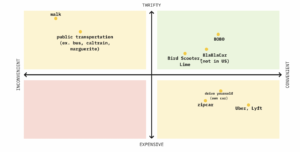Comparative Research

2×2 learnings:
- Uber, Lyft:
- Very convenient → just call right when you need it, very expensive, very large user base, lots of safety measures taken, various riding options and pricing based on size/luxury of a car, subscription model tied with other apps for Uber (ex. UberEats), split the fare options amongst riders
- Public transportation:
- Quality and convenience definitely vary across regions,
- Zipcar:
- on-demand service and automobile reservations to its members who want a car-free lifestyle
- Covers gas, insurance options,* parking and maintenance
- available in over 1,500 cities and towns
- charged extra for returning late – higher fee (ex. $50)
- BlaBlaCar:
- A long-distance carpooling app that connects traveling car owners and people looking for rides in the same direction
- Currently available in 22 European and Latin American countries
- Rider: find your desired ride, and pay your driver in cash at the end of the ride
- Driver: post your trip, vehicle information, and price per rider.
- chat features view each other’s profiles, which display ratings, preferences, a mini bio
- Users can even select their preferred level of conversation, between “Bla” (fairly quiet) and “BlaBlaBla” (talkative).
- Safety:
- government-issued IDs, mutual Facebook and LinkedIn connections, user’s experience level, % of positive ratings, and how long they’ve been on the platform.
- woman travelers → can use the “Ladies Only” feature to ensure you match with other women for your trips.
- Drivers do not earn a profit by using the BlaBlaCar app →riders only contribute gas
- Riders are charged a 10-12% transaction fee with every ride
- Ridepool:
- Share uber rides among Stanford students
- Users get to schedule rides the want to go on and the website matches the with other students who want to go on the same trip
Participatory Roadmapping
Notes:
- Safety onboarding is a more prioritized feature for riders than drivers → might be due to effort, feeling like they are safe, good people (ie don’t need this from their pov)
- Payment system and pricing are important features
- More specific questions about pricing – how would a “zone” based system work? Would it be traveling within a county (ex. $5 for any trip in Santa Clara county?) or based on distance (ex. Buckets of 1-3miles: $3, 3-6 miles: $5, etc)
- Drivers and riders both want to be able to specify trip details and see trip details to know expectations (ex. Time, location) for clarity of communication
